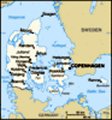Advertisement
Herning, Esbjerg, Fano Island and Ribe 27 & 28 June
After our tyres were fitted we drove to Herning region to Birk where we had read that there was an extensive area for Denmark's display of art, architecture and landscape. it was an area where the country's textile industry started. In the 60s there was a large shirt factory built, giving employment to the region. This design theme quickly extended to environmental design, art and architecture. The long list of things we saw was:
· Angli, a round, white building which used to be the shirt factory and is now a design school and office facilities
· Carl-Henning Pedersen & Else Alfelt's Museum - a round building and the pyramid which both were covered by mosaics
· Allotment which consists of 116 figures of concrete in different heights each symbolising the citizens of Hvide Sande from 2 to 80 years old.
· The Sculpture Park
· The Geometrical Gardens
· The Students' City
· A University
· Abyss & Elia - a sculpture as well as architecture, and a giant circle with 4 columns and 4 stairways in the middle of the
top
· The Utzon House (you may remember one of previous blogs mentioned him as the designer of the Sydney Opera House
· and the HEART, Herning Museum of Contemporary Art .....very contemporary!!!
It was a pretty area to walk around and visit some of the buildings. It started to rain while we were there, but not heavily.
Off we went to Esbjerg on the west coast (popn 72,000) with its oil refineries, smoke-stacks and silos, busy harbour, but with a handsome town square. However when we were there, the town square was covered with beer cans and half the cafes were full of uni students, all with their little graduand 'sailor' hats on. I think they all had a great night the day before.
We then decided to catch a ferry to the island of Fano. This took less than 20 minutes. We found a beautiful almost time-warped village. There are 2 little villages, one at each end of the island. Most of the streets are cobble stoned and some of the houses had thatched rooves. It was interesting looking in the little shops that lined some of the streets. It was very quiet
over there and apparently a place to 'get away from it all'.
We found a quaint little pub on the waterfront and sat down for a cold beer before catching the ferry back to the mainland.
It was heading on towards the evening so we drove about 30kms south to Ribe, another charming town with crooked cobblestoned streets. This town of 8,200 people was established in AD 869, making it one of Scandinavia's oldest towns and Denmark's most attractive towns and also the best preserved medieval town with many preserved buildings. We saw a lot of with half-timbered houses and enjoyed the atmosphere, the cosy cafés and the speciality shops.
It was easy to find the Ribe Camp Site which gave us a stack of information on the town. This included info about the Ribe Cathedral where the view from the top of the church tower, was overseeing the complete town of Ribe, surrounded by flat moors as far as the eye stretches. The view from above, of the city and the river running through it, gives a good impression of the medieval and Viking origins of the city.
Ribe also has a Night Watchman. Every
evening in the summer people can may accompany the night watchman in Ribe on his route through the old, winding streets, while he is singing to alert citizens about bedtime approaching. Along the way he tells you tales about witches, floods and fires.
We also visited the Ribe Viking Centre which is a little out of town. This provided us with a unique experience and new knowledge about the Viking Age. We wandered round the reconstructed life-size Viking estate, where people who worked there were dressed up like Vikings, and who we talked to, to learn about the Viking days of yesteryears. There was archery, the feeding of farm animals, weaving and spinning, the carving of wooden weapons and generally maintaining the estate, all done by the young ones who worked there. There were lots of activities, particularly for children.
Back in town there is also a Viking Museum which we didn't visit. We did however visit the Town Hall (Rathus) with its big wooden circular staircase, its walls adorned with past heads of Government and the history of the building. It started as a private home in 1496 but became a Town Hall in 1708. It was
in 2007 that it became a Museum. In this museum is also a display of prison paraphernalia, including chains, thumbscrews and an executioners sword. This sword had 3 small holes in its tip for the fixing of lead weights, to give extra power to the chop - nice!!!
The town was definitey worth the visit.
There was certainly a sense of open space in this region, with rolling plains, mostly covered by crops. Their road system is fantastic, with lots of big roundabouts with very few traffic lights. At this stage of the year, everything is so green.
The Camping site in Ribe was very well appointed, and the people were so helpful - and everyone wants to come to Australia or know of someone who has been there or is there.
Advertisement
Tot: 0.6s; Tpl: 0.027s; cc: 22; qc: 70; dbt: 0.247s; 1; m:domysql w:travelblog (10.17.0.13); sld: 2;
; mem: 1.3mb























